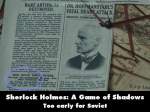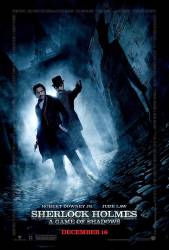Factual error: In the scene straight after the opening credits we are taken to Baker Street where construction work is being done. This work is identified by a sign with a logo as being for the underground line. The logo type face was developed by a Mr. Edward Johnston for London Underground from 1913 but the distinctive typeface used in the film was not in place until 1919. This is obviously long after the 1891 setting of the film.
Factual error: In the scene where Holmes enters the factory in Germany, a map can be seen on a table with small German black-red-gold tricolor flags sticking up from it. However, the flag of the 2nd German Empire at the time of the film's setting (1891) was black, white, and red, and was so from 1871-1918.
Factual error: In Paris, Colonel Moran gives a ticket for Don Giovanni to Moriarty. The ticket lists the performance date as "Mardi 7 Novembre." Mardi means Tuesday in French, except in 1891 November 7 was a Saturday. (00:52:20)

Factual error: When Watson is looking at the spiderweb of clues in Holmes' apartment, he is shown a newspaper article about the bombing and doctor's death. The lower left of the clipping shows a story with title "Soviet Government Money For The General Strike." The movie is set in 1891, and the term Soviet first came into use in 1905 to describe a worker's movement in Russia, but a Soviet Government didn't exist until 1917. (00:16:00)
Other mistake: In Moriarty's college study, the white King and Queen chess pieces are actually on the wrong squares. Queen starts on her own color.
Factual error: In the opening scene Watson is typing on an Underwood typewriter. Given the last scene of the movie, the first scene took place shortly after Holmes' "death", namely in 1891, or maybe 1892. Underwood started making typewriters in 1895 but those were labeled as "Wagner." The Underwood label was first used in 1900.
Other mistake: When Holmes and his gang are running from the Germans through the forest, one of Moriarity's German lackeys yells that it is time to introduce them to "Little Hansel" (in subtitles). Strangely, what he really yelled was, "zu viele Fuchse fur euch paar Huhner," or "too many foxes for those few chickens." Not sure why they made such a change in dialogue (where the German phrase was ever thought to fit in).
Factual error: In the scene at the peace-conference, Sherlock says that he had been to one of the professor's lectures in Oslo, although Oslo was called Christiania during Sherlock's entire life period, and wasn't renamed before 1925.
Continuity mistake: The first time Sherlock shows his camouflage suit, its brown colour changes between the first and second shot. The first one matches exactly that of the room, but the second doesn't. Clearly the first one was achieved with a green-chroma-suit, and the second angle was a coloured fabric.
Other mistake: In the scene when Sherlock Holmes and his crew are running through the forest, the barrel of "Little Hansel" can be seen being raised up to 50°, which would cause a parabolic trajectory, but the shell travels in a horizontal path as it blasts through a tree and past Holmes. (01:30:25)
Continuity mistake: The handkerchief on Moriarty's chess table changes positions between shots.
Continuity mistake: Position of hat changes when Watson wakes up at his wedding.
Factual error: When Holmes and Watson climb back into the train carriage, Watson pulls the door shut with ease. As the train is going quite fast (50+ mph) and the door opens against the carriage it would be take a lot more effort to close, as he is pulling it against the wind the train is producing.
Continuity mistake: In the ballroom scene of the peace conference, Sherlock is dancing with Madame Simsa in the close-up, when the shot goes to the wide shot of the dancing, the dancing Sherlock and Simsa are nowhere to be seen, instead Simsa can be seen in the lower left hand corner of the scene, talking to Watson.
Factual error: At one point, Sherlock uses a tube of lipstick to sabotage a gun. The film is set in the late 19th century, and tube lipstick wasn't available until 1915.
Continuity mistake: Initially during the forest chase scene, Watson is on Sherlock's right side and Madam Simza on the left. After Little Hansel is shot which throws them forward, Watson is now on Sherlock's left side and vice versa.
Factual error: At the end of the film as both men go through the motions of what may happen Moriarty uses the term the haymaker punch. The film is set in 1891 and the term haymaker punch wasn't introduced until the early 20th century, about 1917.
Factual error: On the train after escaping the munitions factory, Holmes stops breathing and after checking for a pulse, Watson begins chest compressions. This is taking place in 1891, however chest compressions were only first proposed in academia in 1891 and the first successful use wasn't until 1903, and even then wasn't in the CPR fashion Watson was using. (01:34:00)
Continuity mistake: The soldiers on the train that are set on fire simply disappear once the door is closed, including the fire.
Continuity mistake: When they are running through the woods, the marksmen shoots one of the fleeing gypsies. The scene goes to slow-mo and we see the bullet goes through him and hits the tree behind him. When the scene switches to the women watching him fall, the tree behind him is unmarked.






Answer: They have direct evidence that Moriarty is trying to start an international conflict and trigger a war to profiteer from. It makes perfect sense for the police to seize Moriarty's assets and fortune since they're being used for and were attained from major criminal activity.
TedStixon